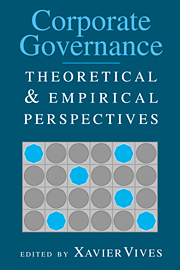Book contents
- Frontmatter
- Contents
- Preface
- Contributors
- 1 Corporate Governance: Does It Matter?
- 2 Corporate Governance and Competition
- 3 On the Economics and Politics of Corporate Finance and Corporate Control
- 4 How Do Financial Systems Affect Economic Performance?
- 5 Information and Governance in the Silicon Valley Model
- 6 The Governance of the New Enterprise
- Index
1 - Corporate Governance: Does It Matter?
Published online by Cambridge University Press: 05 June 2012
- Frontmatter
- Contents
- Preface
- Contributors
- 1 Corporate Governance: Does It Matter?
- 2 Corporate Governance and Competition
- 3 On the Economics and Politics of Corporate Finance and Corporate Control
- 4 How Do Financial Systems Affect Economic Performance?
- 5 Information and Governance in the Silicon Valley Model
- 6 The Governance of the New Enterprise
- Index
Summary
Introduction
The influential work of Berle and Means (1932) suggested that the modern corporation was run by professional managers who were unaccountable to dispersed shareholders. This pointed to a narrow view of corporate governance (CG): how to ensure that managers follow the interests of shareholders. This view fits in the principal–agent paradigm. The principals (shareholders) have to solve an adverse selection problem: select good managers. They also have to solve a moral hazard problem: check that the managers put forth appropriate effort and make decisions aligned with the interests of shareholders (for example, taking the right amount of risk and not pursuing their own private benefits). “Somewhat more generally we can define corporate governance as the set of methods to ensure that investors (suppliers of finance, shareholders, or creditors) get a return on their money.” (Shleifer and Vishny 1997)
More recently a broader definition of corporate governance, related to the concept of the stakeholder society, is gaining ground (see, for example, Kay 1996). A firm has many stakeholders other than its shareholders: employees, customers, suppliers, and neighbors, whose welfare must be taken into account. Corporate governance would refer then to the design of institutions to make managers internalize the welfare of stakeholders in the firm (Tirole 1999).
- Type
- Chapter
- Information
- Corporate GovernanceTheoretical and Empirical Perspectives, pp. 1 - 22Publisher: Cambridge University PressPrint publication year: 2000
- 18
- Cited by



